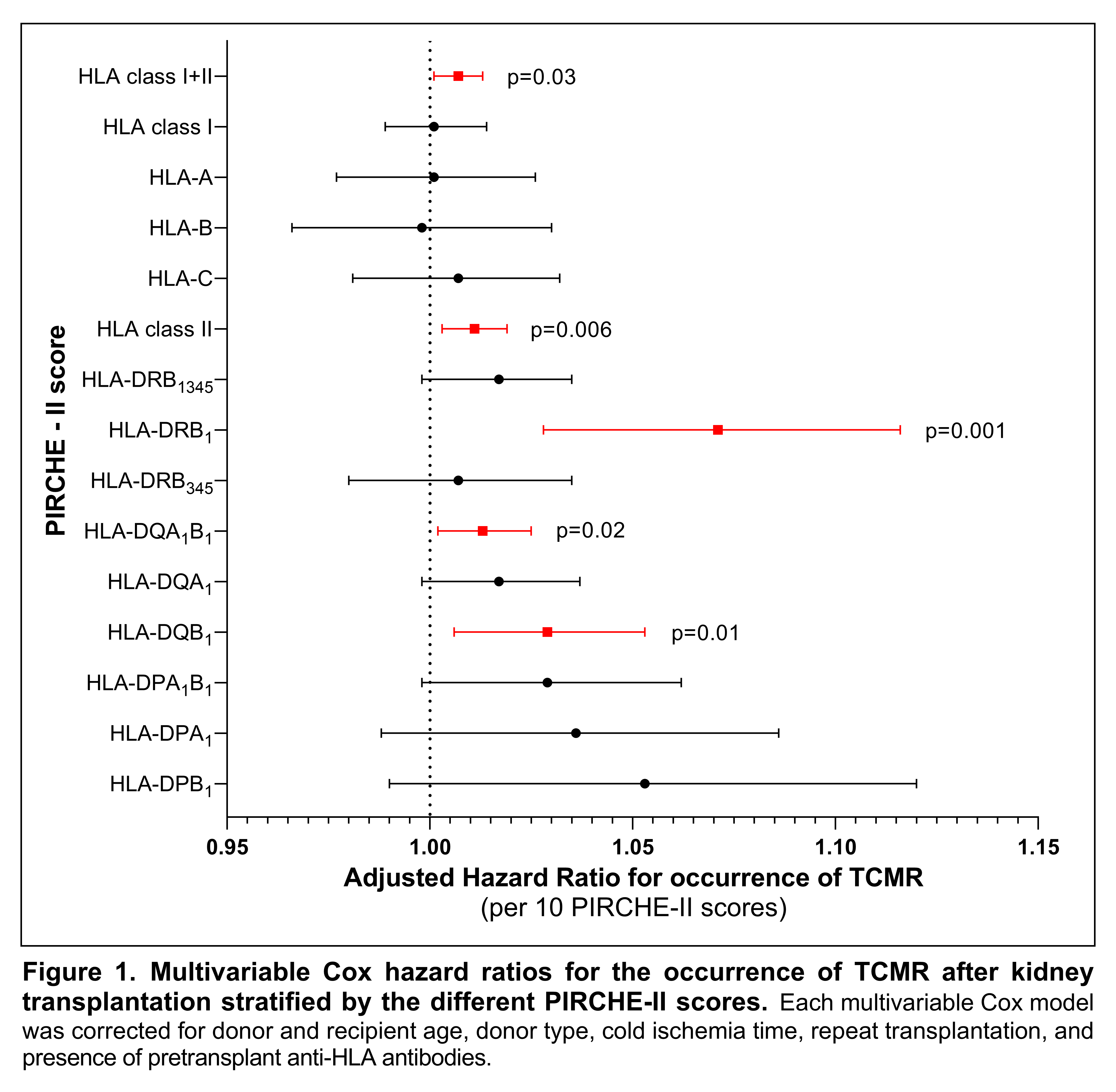The Effect of the Different Donor-Derived HLA T-Cell Epitope Targets on the Development of T Cell-Mediated Rejection After Kidney Transplantation
Microbiology, Immunology and Transplantation, KU Leuven, Leuven, Belgium
Meeting: 2021 American Transplant Congress
Abstract number: 234
Keywords: Histocompatibility antigens, Kidney transplantation, Rejection, T cell graft infiltration
Topic: Clinical Science » Kidney » Kidney: Acute Cellular Rejection
Session Information
Session Name: Kidney: Acute Cellular Rejection
Session Type: Rapid Fire Oral Abstract
Date: Monday, June 7, 2021
Session Time: 4:30pm-5:30pm
 Presentation Time: 4:35pm-4:40pm
Presentation Time: 4:35pm-4:40pm
Location: Virtual
*Purpose: Many kidney allografts fail due to rejections caused by the donor and recipient HLA incompatibility. Recent studies have shown that HLA-DR and DQ mismatches are particularly harmful by inducing donor-specific HLA antibodies and causing antibody-mediated rejection. However, due to the absence of HLA-specific biomarkers, it remains unknown which HLA mismatches contribute the most to the development of T-cell mediated rejection (TCMR). In this study, we aimed to investigate the associations of the different donor-HLA-derived T-cell epitope targets, PIRCHE-II scores, and the occurrence of TCMR after kidney transplantation.
*Methods: Patients who underwent kidney transplantation between 2004-2013 were included in this study (N=926 with 3515 biopsies, both indication and protocol biopsies). These patients and donors were genotyped at the 2nd field high-resolution HLA level. We used the PIRCHE-II algorithm to calculate the different donor-HLA-derived T-cell epitope scores for all HLA loci.
*Results: The median PIRCHE-II score of our cohort was 311.5 (IQR 205-453), and highest in HLA-DQA1B1 molecule (76.5; IQR 7-162). 277 patients (29.9%) developed TCMR and 134 (14.5%) developed only borderline changes on at least one allograft biopsy. In a multivariable analysis adjusted for confounders (Figure 1), the total PIRCHE-II score was independently associated with an increased risk for developing TCMR (per 10, HR=1.007; 95%CI 1.001-1.013; p=0.03), mainly explained by the PIRCHE-II scores for HLA-DRB1 (HR=1.071; 95%CI 1.028-1.116; p=0.001) and HLA-DQA1B1 molecules (HR=1.013; 95%CI 1.002-1.025; p=0.02). The same associations with PIRCHE-II scores for HLA-DRB1 and DQA1B1 were found when borderline changes are counted as TCMR. In a sensitivity analysis restricted to HLA-DSA negative patients, again, only the T-cell epitope targets originating from the donor’s HLA-DRB1 and HLA-DQA1B1 molecules were associated with TCMR. Finally, the same PIRCHE-II scores for HLA-DRB1 (HR=1.042; 95%CI 1.005-1.081; p=0.02) and HLA-DQA1B1 molecules (HR=1.015; 95%CI 1.005-1.026; p=0.0035) were risk factors for all-cause graft failure, independent of HLA-DSA antibodies.
*Conclusions: PIRCHE-II scores for HLA-DRB1 and HLA-DQA1B1 are independent predictors for TCMR development and independent risk factors for all-cause graft failure after kidney transplantation, and could be used for improved risk stratification.
To cite this abstract in AMA style:
Senev A, Loon EVan, Emonds M, Naesens M. The Effect of the Different Donor-Derived HLA T-Cell Epitope Targets on the Development of T Cell-Mediated Rejection After Kidney Transplantation [abstract]. Am J Transplant. 2021; 21 (suppl 3). https://atcmeetingabstracts.com/abstract/the-effect-of-the-different-donor-derived-hla-t-cell-epitope-targets-on-the-development-of-t-cell-mediated-rejection-after-kidney-transplantation/. Accessed December 18, 2025.« Back to 2021 American Transplant Congress

